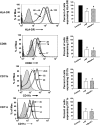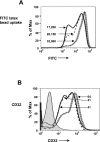Apolipoprotein A-I mimetic 4F alters the function of human monocyte-derived macrophages
- PMID: 20219948
- PMCID: PMC2889631
- DOI: 10.1152/ajpcell.00467.2009
Apolipoprotein A-I mimetic 4F alters the function of human monocyte-derived macrophages
Abstract
HDL and its major protein component apolipoprotein A-I (apoA-I) exert anti-inflammatory effects, inhibit monocyte chemotaxis/adhesion, and reduce vascular macrophage content in inflammatory conditions. In this study, we tested the hypothesis that the apoA-I mimetic 4F modulates the function of monocyte-derived macrophages (MDMs) by regulating the expression of key cell surface receptors on MDMs. Primary human monocytes and THP-1 cells were treated with 4F, apoA-I, or vehicle for 7 days and analyzed for expression of cell surface markers, adhesion to human endothelial cells, phagocytic function, cholesterol efflux capacity, and lipid raft organization. 4F and apoA-I treatment decreased the expression of HLA-DR, CD86, CD11b, CD11c, CD14, and Toll-like receptor-4 (TLR-4) compared with control cells, suggesting the induction of monocyte differentiation. Both treatments abolished LPS-induced mRNA for monocyte chemotactic protein-1 (MCP-1), macrophage inflammatory protein-1 (MIP-1), regulated on activation, normal T-expressed and presumably secreted (RANTES), IL-6, and TNF-alpha but significantly upregulated LPS-induced IL-10 expression. Moreover, 4F and apoA-I induced a 90% reduction in the expression of CD49d, a ligand for the VCAM-1 receptor, with a concurrent decrease in monocyte adhesion (55% reduction) to human endothelial cells and transendothelial migration (34 and 27% for 4F and apoA-I treatments) compared with vehicle treatment. In addition, phagocytosis of dextran-FITC beads was inhibited by 4F and apoA-I, a response associated with reduced expression of CD32. Finally, 4F and apoA-I stimulated cholesterol efflux from MDMs, leading to cholesterol depletion and disruption of lipid rafts. These data provide evidence that 4F, similar to apoA-I, induces profound functional changes in MDMs, possibly due to differentiation to an anti-inflammatory phenotype.
Figures







References
-
- Anantharamaiah GM, Hughes TA, Iqbal M, Gawish A, Neame PJ, Medley MF, Segrest JP. Effect of oxidation on the properties of apolipoproteins A-I and A-II. J Lipid Res 29: 309–318, 1988 - PubMed
-
- Anantharamaiah GM, Jones JL, Brouillette CG, Schmidt CF, Chung BH, Hughes TA, Bhown AS, Segrest JP. Studies of synthetic peptide analogs of the amphipathic helix. Structure of complexes with dimyristoyl phosphatidylcholine. J Biol Chem 260: 10248–10255, 1985 - PubMed
-
- Anantharamaiah GM, Mishra VK, Garber DW, Datta G, Handattu SP, Palgunachari MN, Chaddha M, Navab M, Reddy ST, Segrest JP, Fogelman AM. Structural requirements for antioxidative and anti-inflammatory properties of apolipoprotein A-I mimetic peptides. J Lipid Res 48: 1915–1923, 2007 - PubMed
-
- Banchereau J, Steinman RM. Dendritic cells and the control of immunity. Nature 392: 245–252, 1998 - PubMed
Publication types
MeSH terms
Substances
Grants and funding
LinkOut - more resources
Full Text Sources
Other Literature Sources
Research Materials
Miscellaneous

